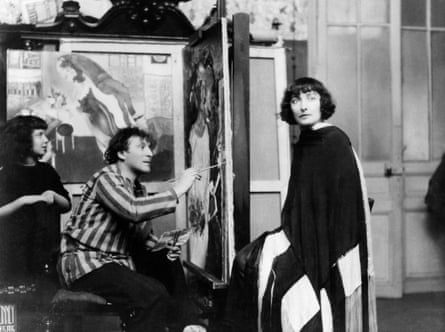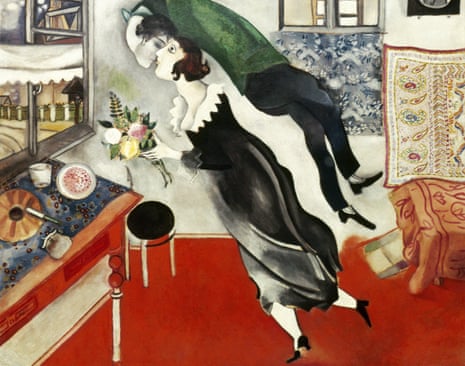From the moment they fell for each other in 1909, Marc Chagall and his wife, Bella, seemed to share a particular way of seeing the world. Bella was a talented writer and her description of their first encounter is like a Chagall painting in words: “When you did catch a glimpse of his eyes, they were as blue as if they’d fallen straight out of the sky. They were strange eyes … long, almond-shaped … and each seemed to sail along by itself, like a little boat.”
Bella swiftly became Marc’s muse and continued to visit his canvases for the rest of his life. Famously, he often depicted himself and Bella flying together, as if their shared joy had such physical force it countermanded the law of gravity itself. In Birthday, they appear surprised by their flight, rising towards the ceiling like two astonished bubbles of ecstasy. In Over the Town, they drift high over Vitebsk, Belarus, as one only flies in dreams, uniquely privileged to share the same floating reverie. There can be few more vivid evocations in art of how it feels to be in love.
The Chagalls’ story is also remarkable because they experienced so much 20th-century history first-hand. In 1911, leaving Bella in Russia, Marc made it to Paris, then the centre of the modernist movement happening in western art. He soon added something revolutionary. “Under his influence, metaphor made its triumphal entry into modern painting,” André Breton, who credited Chagall as the father of surrealism, later said.

Marc returned to Vitebsk in 1914 to marry Bella, and they were trapped in Russia by the outbreak of the first world war. They moved to St Petersburg, and found themselves ringside spectators to the Russian revolutions. Then, for a brief, heady moment, the avant garde became the new establishment in Russian art and Marc was invited to be commissar of visual arts. Bella sensibly advised him to say no, but he accepted the offer to start a new art school in Vitebsk. Official opinion, however, quickly hardened about what was proper proletarian art, and Marc was forced to resign from the school. Apart from a brief, joyful stint designing sets for the Moscow Yiddish theatre, he now found his work unwelcome in Russia.
He, Bella and their five year-old daughter, Ida, left Russia in 1922, never to return. They watched in horror from afar through the 1920s and 30s as the Jewish homeland of their youth was systematically destroyed first by the Communists then by the Nazis. Bella had long neglected her writing to support Marc in his painting, but during the last few years of her life in exile in New York she was moved to write a lyrical memoir in Yiddish, Burning Lights, about her childhood in Vitebsk. In 1944 she died of a throat infection that would now easily be cured with antibiotics.
More than 20 years ago, Emma Rice, Nikki Sved and I made the first version of our show about the Chagalls, The Flying Lovers of Vitebsk (then called Birthday), which was woven as much with song and movement as with words. We had been working together as young actors for a company called Theatre Alibi. After we left we wanted to make something of our own together and hit upon Marc and Bella’s story. We were inspired by a visit we’d made with Alibi, thanks to directors Alison Hodge and Tim Spicer, to the Gardzienice, the European Centre for Theatre Practices in Poland.

Gardzienice’s actors took us on expeditions to remote corners of the country to gather songs and stories. I went to the forests on the border between Belarus and Poland, only a few hundred miles from Vitebsk. The wooden houses, birch forests and horse-drawn carts of Chagall’s paintings were still in evidence. One evening, an old woman took us to a small copse outside a village. She led us right to the middle of the wood and pointed under our feet. In the twilight, between the roots and ferns, we began to notice fragments of tombstones everywhere that were inscribed in Hebrew script. We were standing in the remains of a Jewish cemetery.
Gardzienice’s work was a torrent of song, language and gravity-defying movement, and there seemed an irresistible connection between their style and Chagall. One night, watching them work, one of their actresses perched like a cat on the shoulder of a double bass. “Look!” said their director Włodzimierz Staniewski, “Pure Chagall!”
Emma says there are no straight lines in Chagall’s paintings – he tailored his perspective to more comfortably suit his wilfully wry view of the world. Watching rehearsals for the new staging of the show, it seems that it has a similar fluidity. As Marc and Bella strive to tell us their story, songs, dances and surprises bubble up irresistibly between the words: a verse of a Russian love song here, a burst of a frantic wedding dance there, a green cow, a morsel of a Yiddish lullaby, a caress that becomes a brushstroke with which to paint another’s body in the air.

There’s an intimacy and informality to this style that suits the theatres to which The Flying Lovers is travelling this summer. In all four venues you feel you could reach out and touch the stage. The show opens this weekend as part of the 250th anniversary of the Bristol Old Vic, which has become almost a second home to Kneehigh over the last decade. From there it continues to the Sam Wanamaker Playhouse at Shakespeare’s Globe which, with its wooden galleries and candle chandeliers, bears an uncanny resemblance to the old synagogue on London’s Princelet Street where we once dreamed of performing the original show. After a week at the Nuffield in Southampton, it finishes at Kneehigh’s Asylum, their very own theatre in a tent, pitched at the Lost Gardens of Heligan in Cornwall. Like Matisse and Picasso, Chagall loved the circus. “Why am I so touched by their makeup and grimaces?” he said. “With them I can move toward new horizons.”
- The Flying Lovers of Vitebsk is at Bristol Old Vic until 11 June and then tours to the Sam Wanamaker Playhouse, London, the Nuffield in Southampton and the Asylum, Cornwall until 31 July

Comments (…)
Sign in or create your Guardian account to join the discussion